sensor TOYOTA C-HR 2022 Service Manual
[x] Cancel search | Manufacturer: TOYOTA, Model Year: 2022, Model line: C-HR, Model: TOYOTA C-HR 2022Pages: 818, PDF Size: 113.75 MB
Page 452 of 818
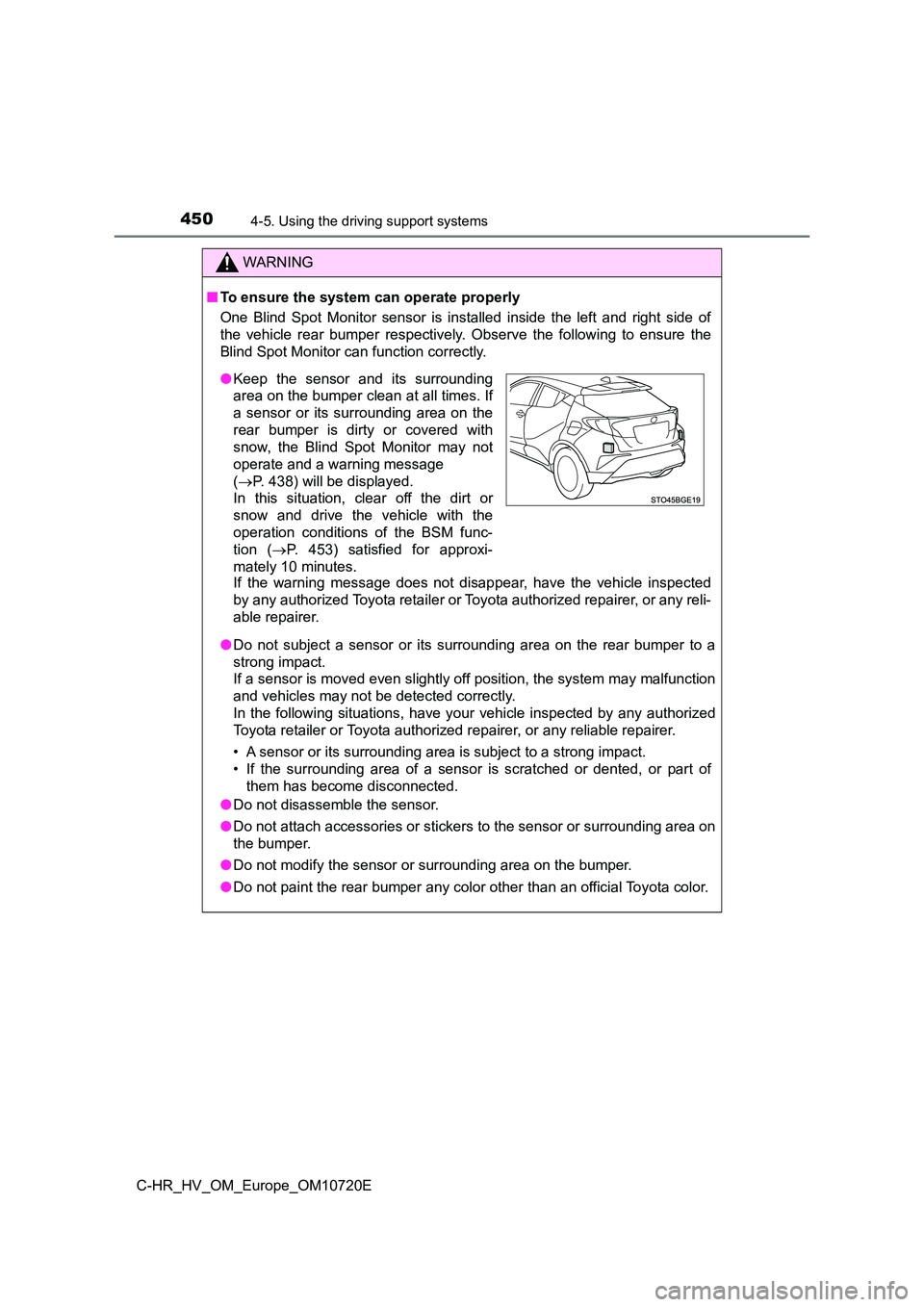
4504-5. Using the driving support systems
C-HR_HV_OM_Europe_OM10720E
WARNING
■To ensure the system can operate properly
One Blind Spot Monitor sensor is installed inside the left and right side of
the vehicle rear bumper respectively. Observe the following to ensure the
Blind Spot Monitor can function correctly.
If the warning message does not disappear, have the vehicle ins pected
by any authorized Toyota retailer or Toyota authorized repairer , or any reli-
able repairer.
● Do not subject a sensor or its surrounding area on the rear bumper to a
strong impact.
If a sensor is moved even slightly off position, the system may malfunction
and vehicles may not be detected correctly.
In the following situations, have your vehicle inspected by any authorized
Toyota retailer or Toyota authorized repairer, or any reliable repairer.
• A sensor or its surrounding area is subject to a strong impact .
• If the surrounding area of a sensor is scratched or dented, or part of
them has become disconnected.
● Do not disassemble the sensor.
● Do not attach accessories or stickers to the sensor or surrounding area on
the bumper.
● Do not modify the sensor or surrounding area on the bumper.
● Do not paint the rear bumper any color other than an official Toyota color.
●Keep the sensor and its surrounding
area on the bumper clean at all times. If
a sensor or its surrounding area on the
rear bumper is dirty or covered with
snow, the Blind Spot Monitor may not
operate and a warning message
( P. 438) will be displayed.
In this situation, clear off the dirt or
snow and drive the vehicle with the
operation conditions of the BSM func-
tion ( P. 453) satisfied for approxi-
mately 10 minutes.
Page 453 of 818
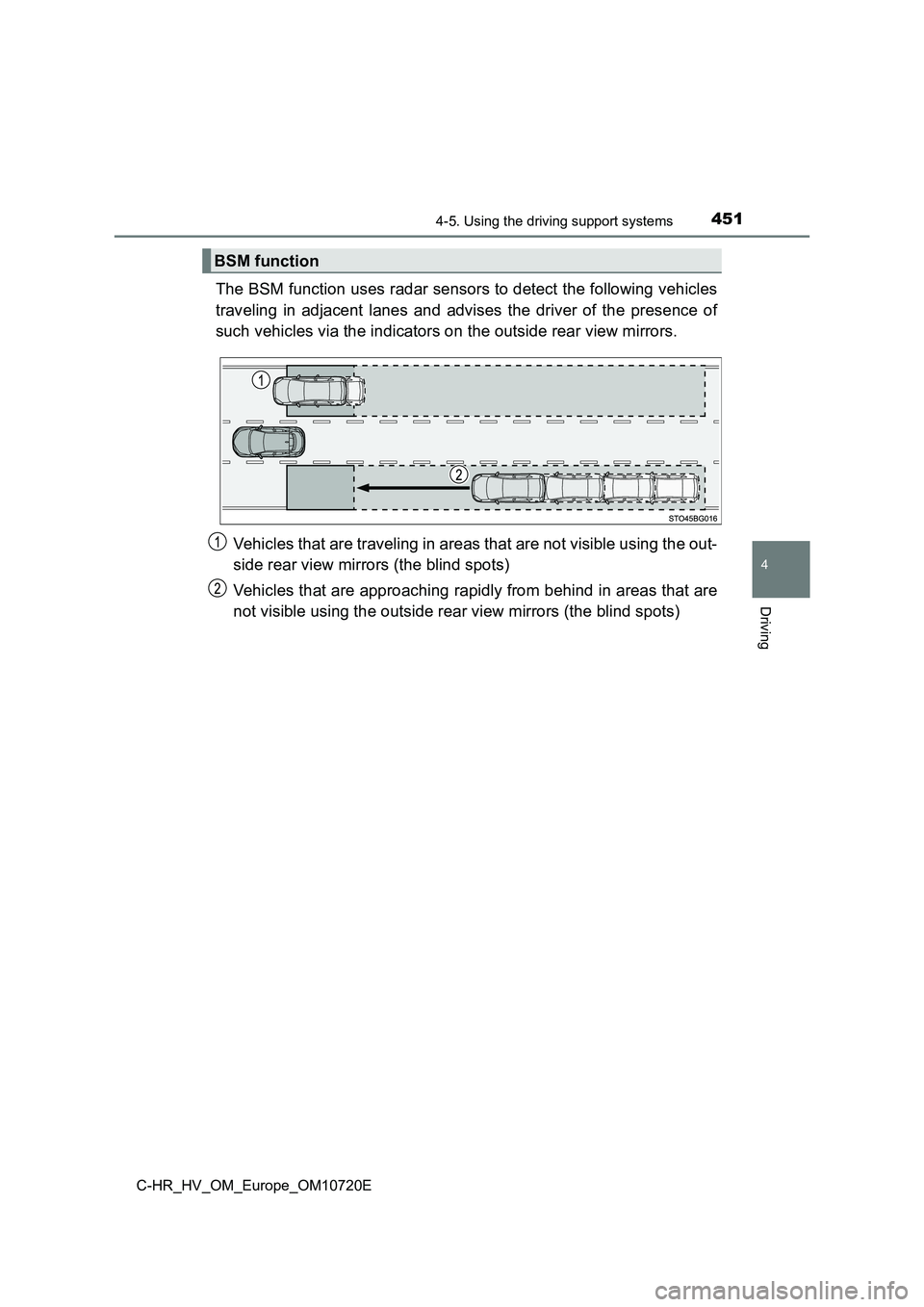
4514-5. Using the driving support systems
4
Driving
C-HR_HV_OM_Europe_OM10720E
The BSM function uses radar sensors to detect the following vehicles
traveling in adjacent lanes and advises the driver of the prese nce of
such vehicles via the indicators on the outside rear view mirro rs.
Vehicles that are traveling in areas that are not visible using the out-
side rear view mirrors (the blind spots)
Vehicles that are approaching rapidly from behind in areas that are
not visible using the outside rear view mirrors (the blind spot s)
BSM function
Page 456 of 818
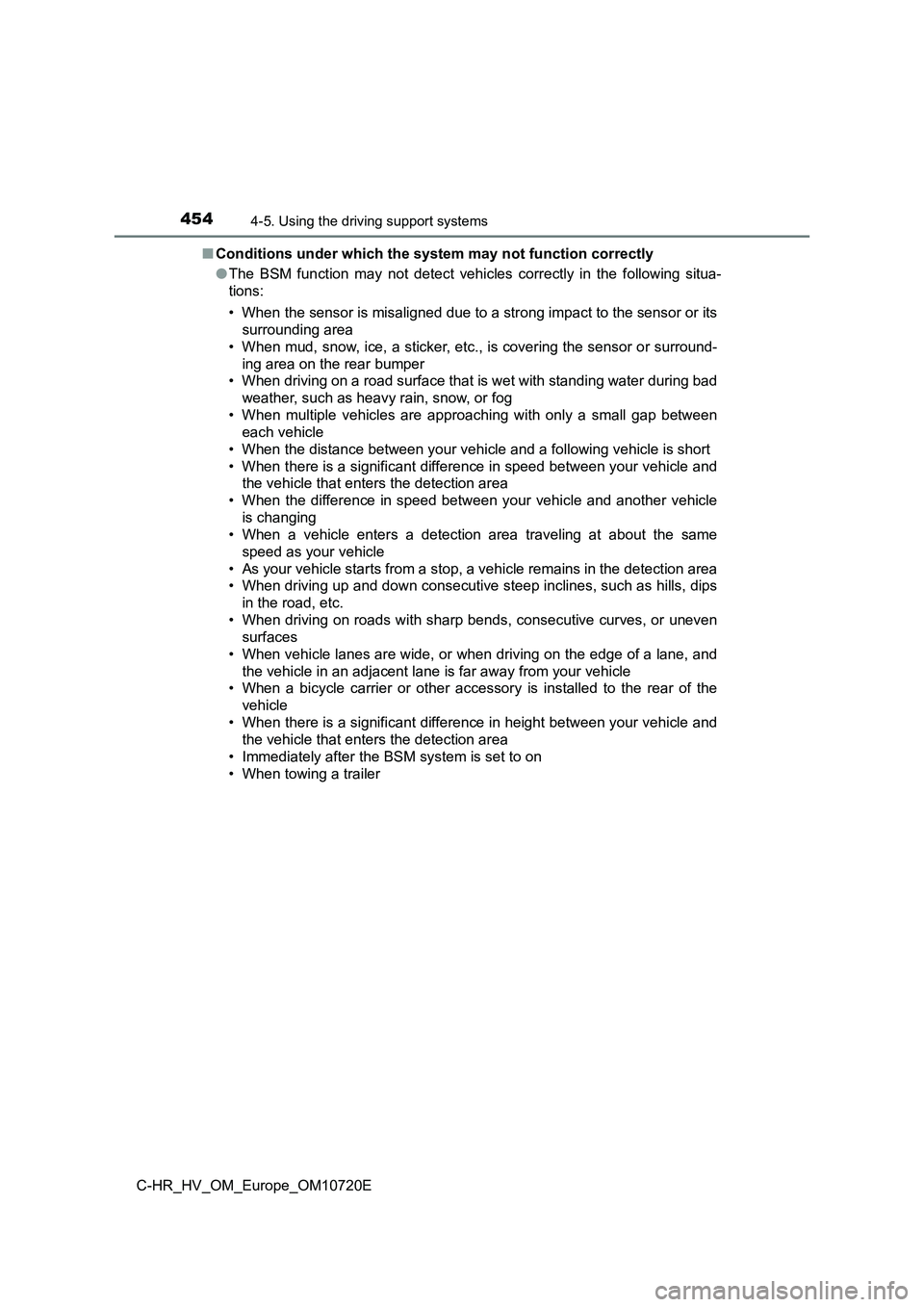
4544-5. Using the driving support systems
C-HR_HV_OM_Europe_OM10720E
■ Conditions under which the system may not function correctly
● The BSM function may not detect vehicles correctly in the following situa-
tions:
• When the sensor is misaligned due to a strong impact to the se nsor or its
surrounding area
• When mud, snow, ice, a sticker, etc., is covering the sensor o r surround-
ing area on the rear bumper
• When driving on a road surface that is wet with standing water during bad
weather, such as heavy rain, snow, or fog
• When multiple vehicles are approaching with only a small gap b etween
each vehicle
• When the distance between your vehicle and a following vehicle is short
• When there is a significant difference in speed between your v ehicle and
the vehicle that enters the detection area
• When the difference in speed between your vehicle and another vehicle
is changing
• When a vehicle enters a detection area traveling at about the same
speed as your vehicle
• As your vehicle starts from a stop, a vehicle remains in the d etection area
• When driving up and down consecutive steep inclines, such as h ills, dips
in the road, etc.
• When driving on roads with sharp bends, consecutive curves, or uneven
surfaces
• When vehicle lanes are wide, or when driving on the edge of a lane, and
the vehicle in an adjacent lane is far away from your vehicle
• When a bicycle carrier or other accessory is installed to the rear of the
vehicle
• When there is a significant difference in height between your vehicle and
the vehicle that enters the detection area
• Immediately after the BSM system is set to on
• When towing a trailer
Page 457 of 818

4554-5. Using the driving support systems
4
Driving
C-HR_HV_OM_Europe_OM10720E
● Instances of the BSM function unnecessarily detecting a vehicle and/or
object may increase in the following situations:
• When the sensor is misaligned due to a strong impact to the se nsor or its
surrounding area
• When the distance between your vehicle and a guardrail, wall, etc., that
enters the detection area is short
• When driving up and down consecutive steep inclines, such as h ills, dips
in the road, etc.
• When vehicle lanes are narrow, or when driving on the edge of a lane,
and a vehicle traveling in a lane other than the adjacent lanes enters the
detection area
• When driving on roads with sharp bends, consecutive curves, or uneven
surfaces
• When the tires are slipping or spinning
• When the distance between your vehicle and a following vehicle is short
• When a bicycle carrier or other accessory is installed to the rear of the
vehicle
Page 458 of 818
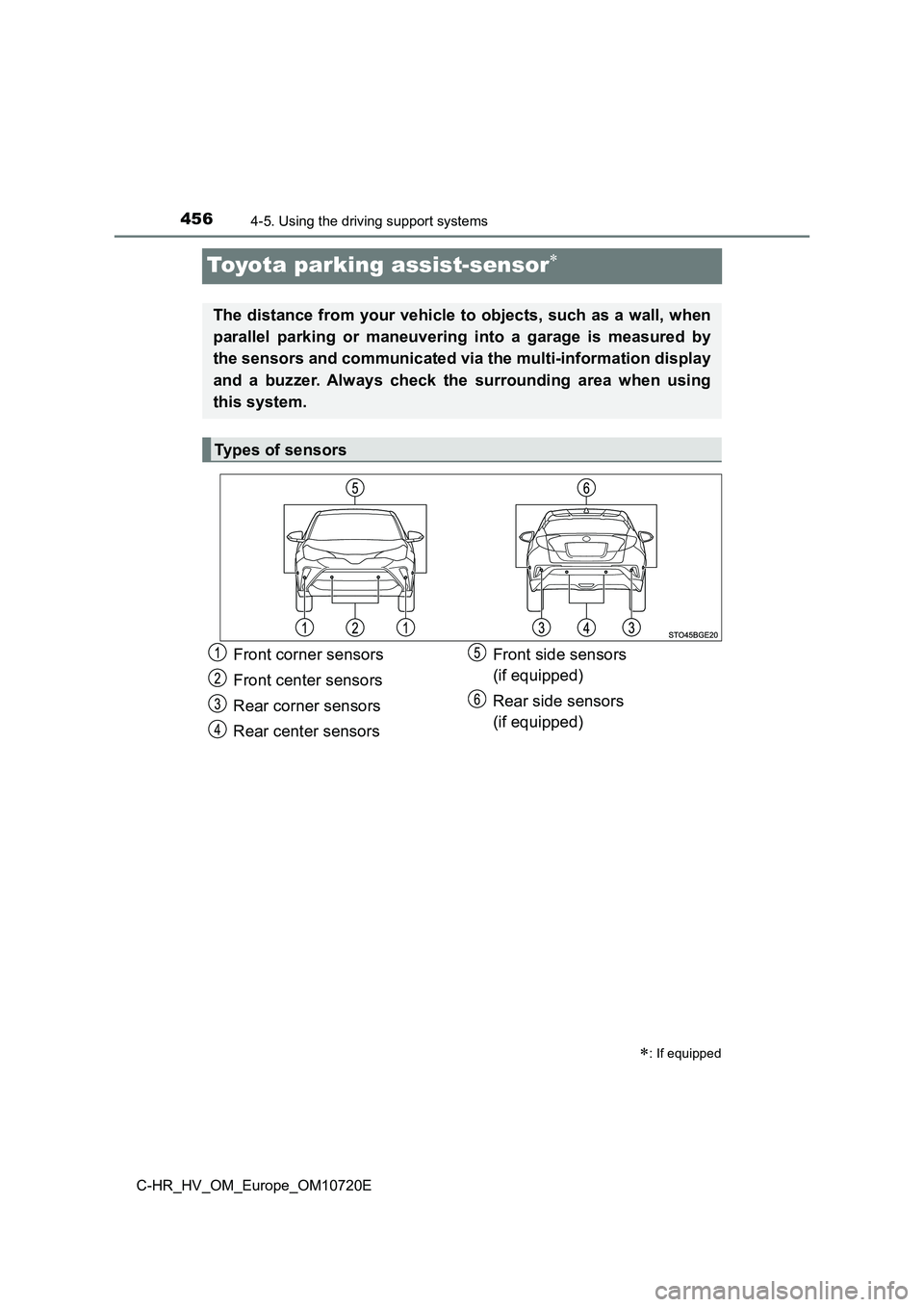
4564-5. Using the driving support systems
C-HR_HV_OM_Europe_OM10720E
Toyota parking assist-sensor
: If equipped
The distance from your vehicle to objects, such as a wall, when
parallel parking or maneuvering into a garage is measured by
the sensors and communicated via the multi-information display
and a buzzer. Always check the surrounding area when using
this system.
Types of sensors
Front corner sensors
Front center sensors
Rear corner sensors
Rear center sensors
Front side sensors
(if equipped)
Rear side sensors
(if equipped)
Page 459 of 818
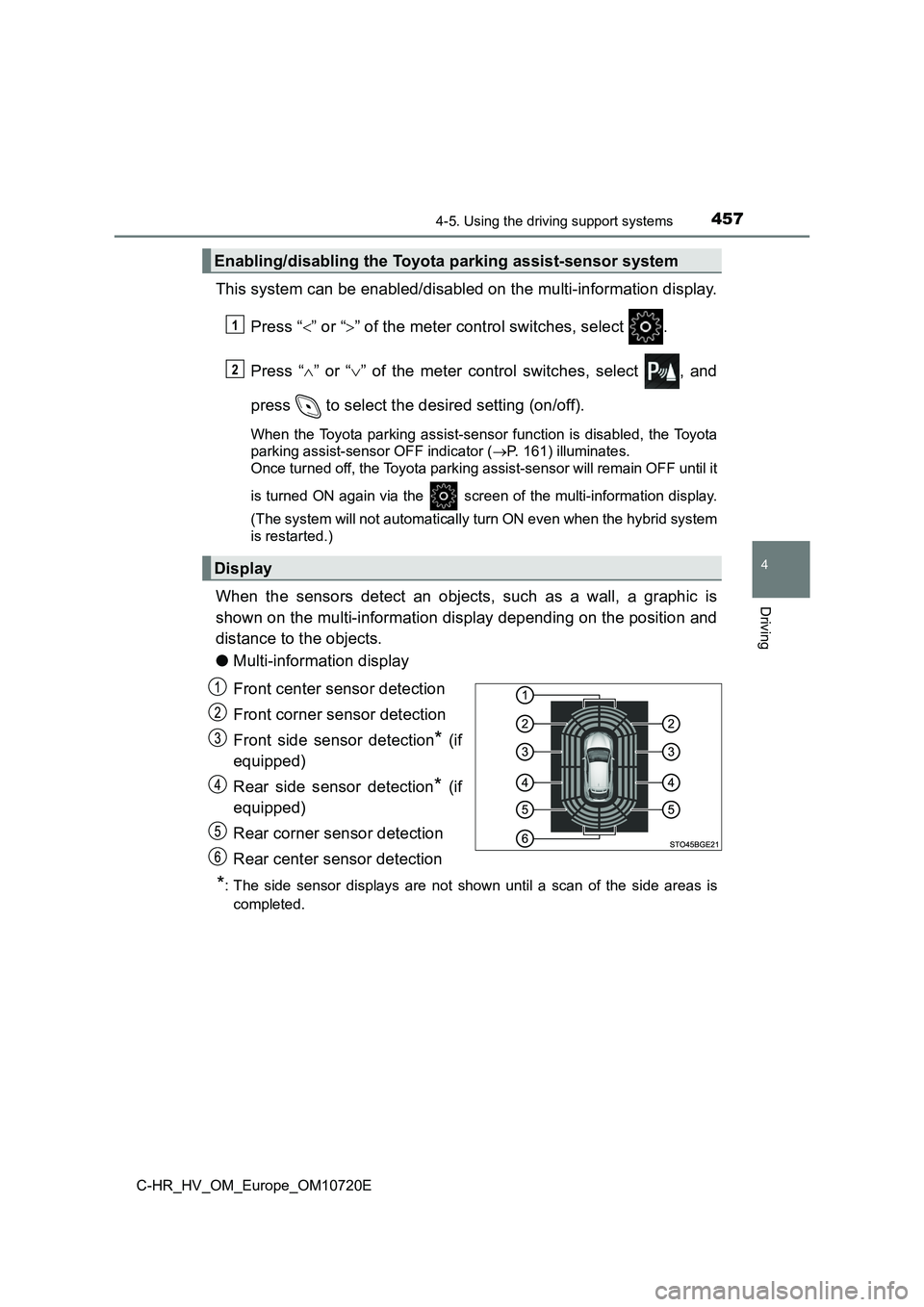
4574-5. Using the driving support systems
4
Driving
C-HR_HV_OM_Europe_OM10720E
This system can be enabled/disabled on the multi-information display.
Press “ ” or “” of the meter control switches, select .
Press “ ” or “” of the meter control switches, select , and
press to select the desired setting (on/off).
When the Toyota parking assist-sensor function is disabled, the Toyota
parking assist-sensor OFF indicator ( P. 161) illuminates.
Once turned off, the Toyota parking assist-sensor will remain O FF until it
is turned ON again via the screen of the multi-information dis play.
(The system will not automatically turn ON even when the hybrid system
is restarted.)
When the sensors detect an objects, such as a wall, a graphic i s
shown on the multi-information display depending on the positio n and
distance to the objects.
● Multi-information display
Front center sensor detection
Front corner sensor detection
Front side sensor detection* (if
equipped)
Rear side sensor detection* (if
equipped)
Rear corner sensor detection
Rear center sensor detection
*: The side sensor displays are not shown until a scan of the sid e areas is
completed.
Enabling/disabling the Toyota parking assist-sensor system
Display
1
2
Page 460 of 818
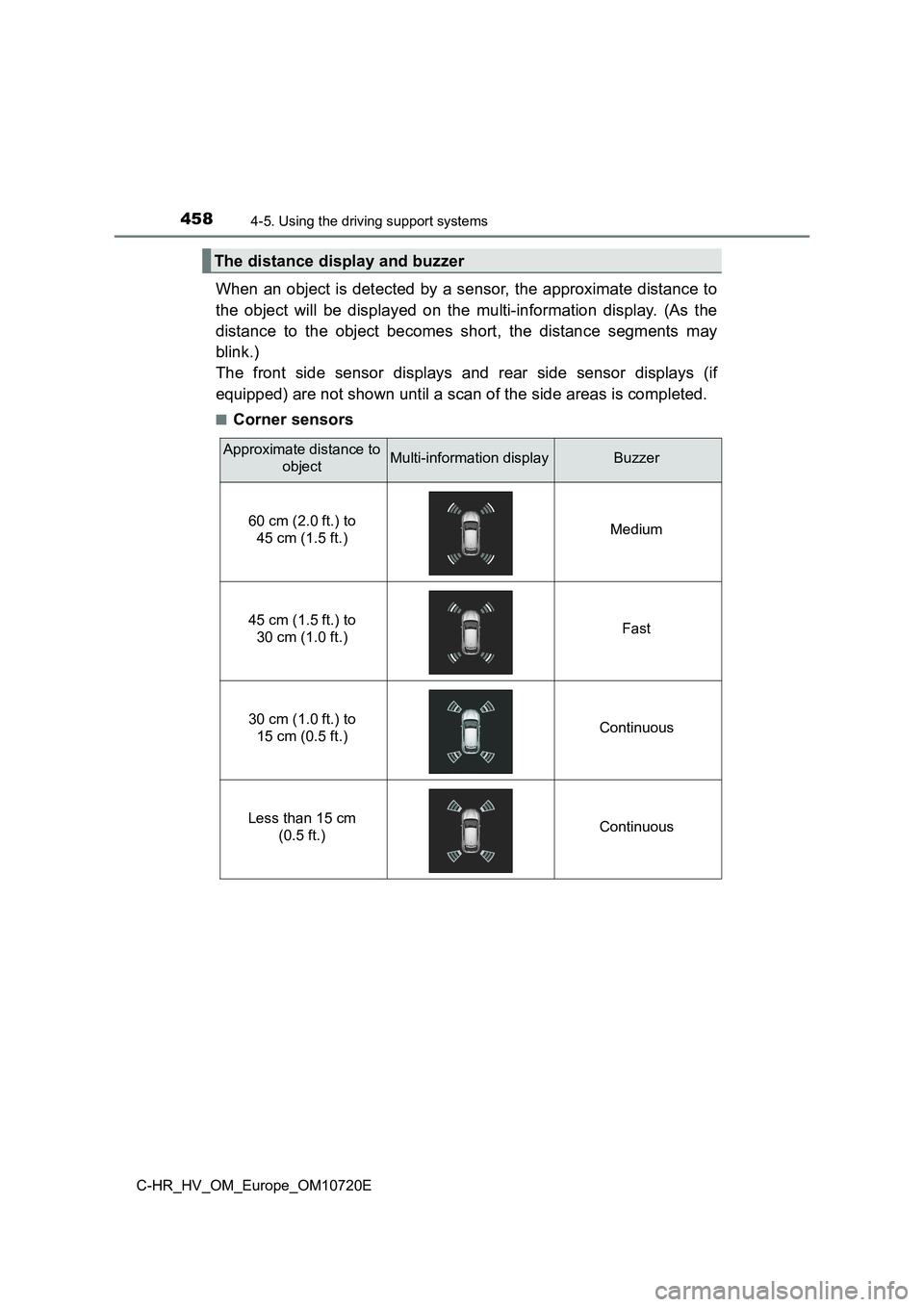
4584-5. Using the driving support systems
C-HR_HV_OM_Europe_OM10720E
When an object is detected by a sensor, the approximate distance to
the object will be displayed on the multi-information display. (As the
distance to the object becomes short, the distance segments may
blink.)
The front side sensor displays and rear side sensor displays (i f
equipped) are not shown until a scan of the side areas is compl eted.
■Corner sensors
The distance display and buzzer
Approximate distance to
objectMulti-information displayBuzzer
60 cm (2.0 ft.) to
45 cm (1.5 ft.) Medium
45 cm (1.5 ft.) to
30 cm (1.0 ft.) Fast
30 cm (1.0 ft.) to
15 cm (0.5 ft.) Continuous
Less than 15 cm
(0.5 ft.) Continuous
Page 461 of 818
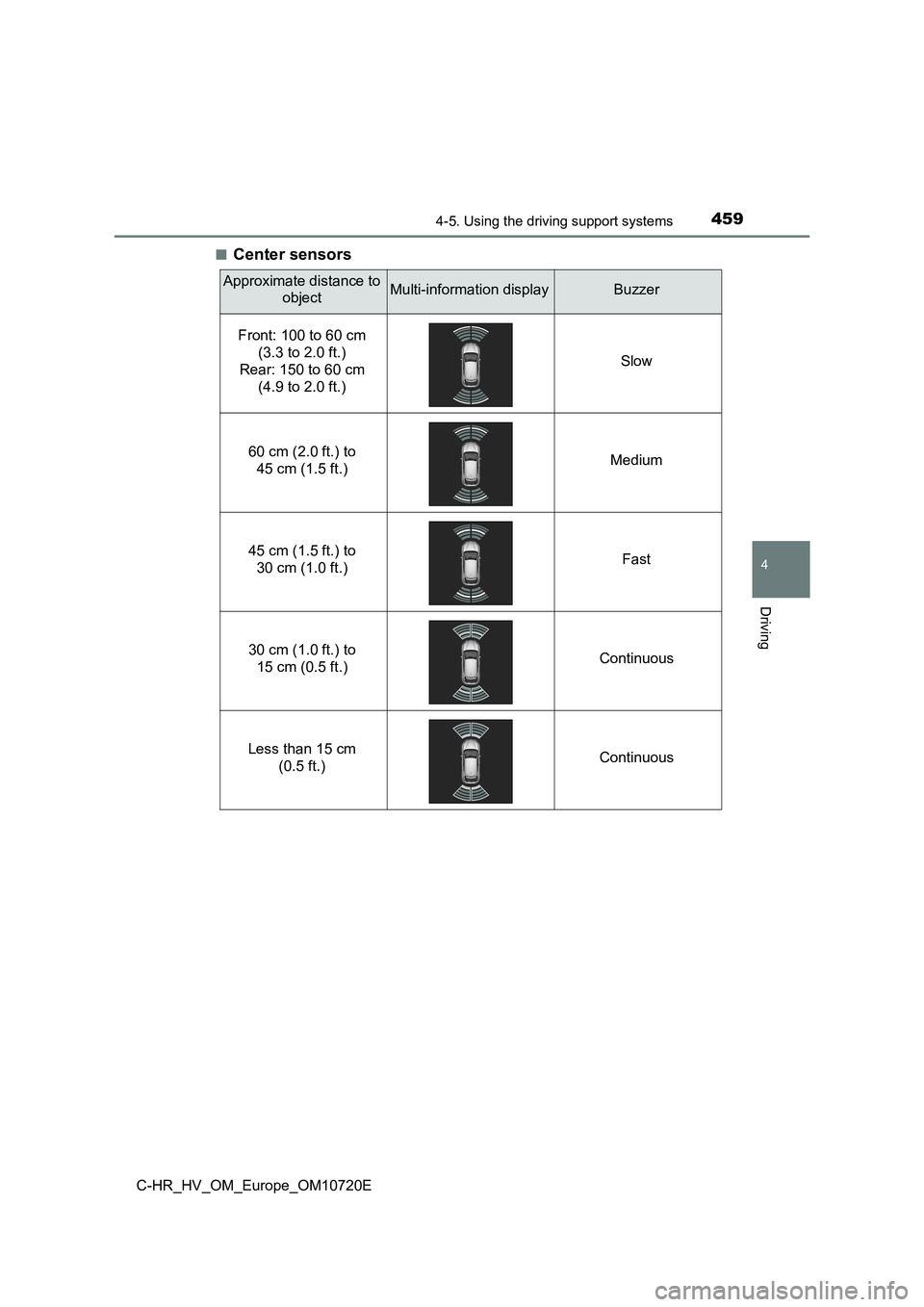
4594-5. Using the driving support systems
4
Driving
C-HR_HV_OM_Europe_OM10720E
■Center sensors
Approximate distance to
objectMulti-information displayBuzzer
Front: 100 to 60 cm
(3.3 to 2.0 ft.)
Rear: 150 to 60 cm
(4.9 to 2.0 ft.)
Slow
60 cm (2.0 ft.) to
45 cm (1.5 ft.) Medium
45 cm (1.5 ft.) to
30 cm (1.0 ft.) Fast
30 cm (1.0 ft.) to
15 cm (0.5 ft.) Continuous
Less than 15 cm
(0.5 ft.) Continuous
Page 462 of 818
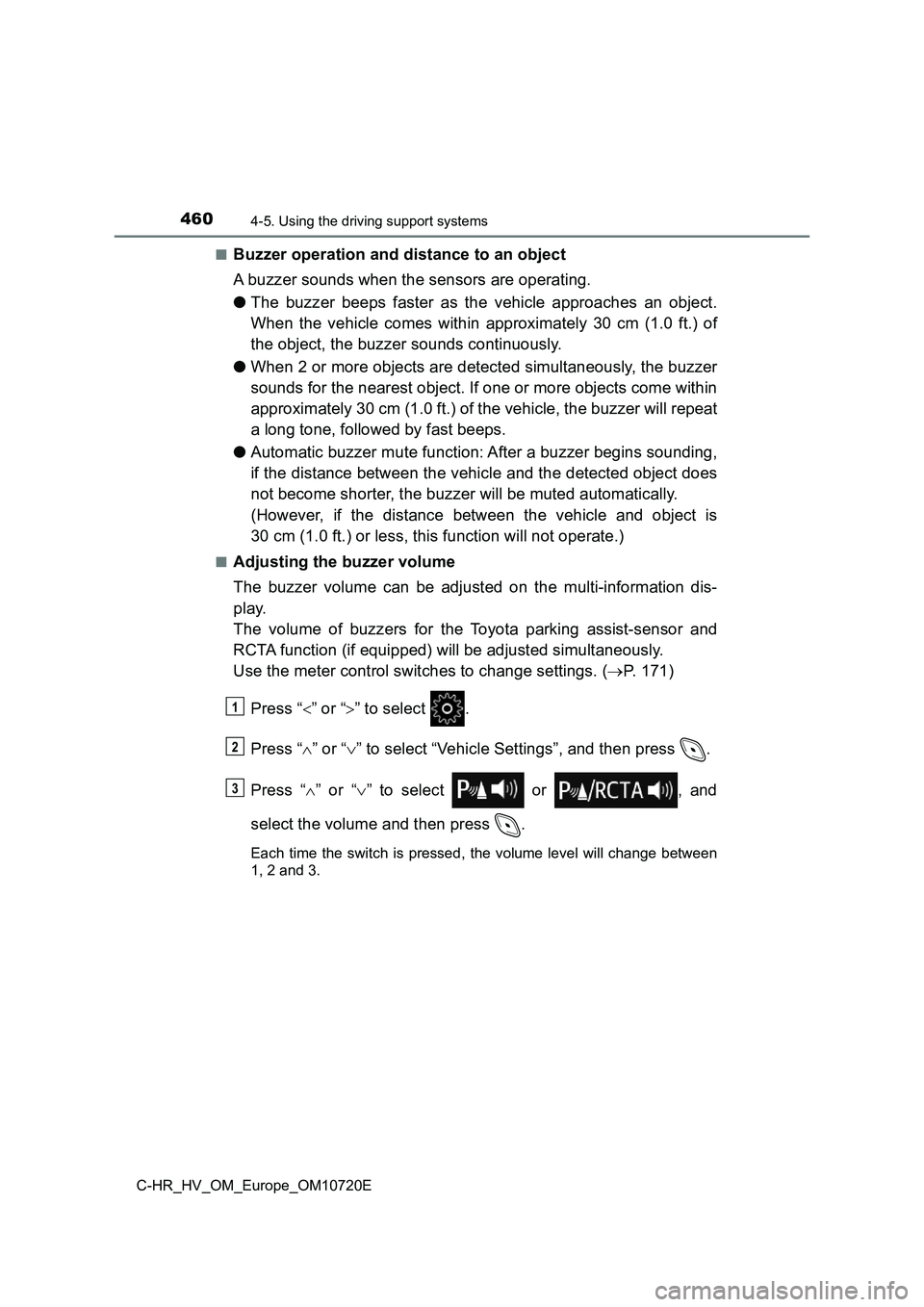
4604-5. Using the driving support systems
C-HR_HV_OM_Europe_OM10720E
■Buzzer operation and distance to an object
A buzzer sounds when the sensors are operating.
● The buzzer beeps faster as the vehicle approaches an object.
When the vehicle comes within approximately 30 cm (1.0 ft.) of
the object, the buzzer sounds continuously.
● When 2 or more objects are detected simultaneously, the buzzer
sounds for the nearest object. If one or more objects come with in
approximately 30 cm (1.0 ft.) of the vehicle, the buzzer will r epeat
a long tone, followed by fast beeps.
● Automatic buzzer mute function: After a buzzer begins sounding,
if the distance between the vehicle and the detected object doe s
not become shorter, the buzzer will be muted automatically.
(However, if the distance between the vehicle and object is
30 cm (1.0 ft.) or less, this function will not operate.)
■Adjusting the buzzer volume
The buzzer volume can be adjusted on the multi-information dis-
play.
The volume of buzzers for the Toyota parking assist-sensor and
RCTA function (if equipped) will be adjusted simultaneously.
Use the meter control switches to change settings. ( P. 171)
Press “ ” or “” to select .
Press “ ” or “” to select “Vehicle Settings”, and then press .
Press “ ” or “” to select or , and
select the volume and then press .
Each time the switch is pressed, the volume level will change b etween
1, 2 and 3.
1
2
3
Page 463 of 818

4614-5. Using the driving support systems
4
Driving
C-HR_HV_OM_Europe_OM10720E
■Muting a buzzer
A mute button will be displayed on the multi-information displa y
when an object is detected. To mute the buzzer, press .
The buzzers for the Toyota parking assist-sensor and RCTA func-
tion (if equipped) will be muted simultaneously.
Mute will be canceled automatically in the following situations :
● When the shift lever is changed.
● When the vehicle speed exceeds a certain speed.
● When the operating function is temporarily canceled.
● When the operating function is disabled manually.
● When the power switch is turned off.
Approximately 100 cm (3.3 ft.)
Approximately 150 cm (4.9 ft.)
Approximately 60 cm (2.0 ft.)
Approximately 60 cm (2.0 ft.) (if
equipped)
• The diagram shows the detection
range of the sensors. Note that
the sensors cannot detect objects
that are extremely close to the
vehicle.
• Vehicles with side sensors: For
details regarding object detection
in the side areas. ( P. 463)
• The range of the sensors may
change depending on the shape
of the object, etc.
Vehicles with side sensors: The object detection range can be
changed. ( P. 7 8 7 )
Detection range of the sensors